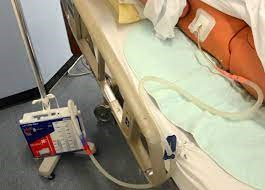A nurse is assisting with the care of a client who has a chest tube.
Which of the following actions should the nurse take?
Strip the client’s chest tube every 2 hours.
Loop the tubing of the chest tube on the client’s bed.
Place the chest tube drainage system above the level of the client’s heart.
Tape the connections on the client’s chest tube.
The Correct Answer is D
Choice A rationale:
Stripping the client’s chest tube every 2 hours is not recommended. Stripping can create high negative pressures in the tube that can cause damage to the lung tissue. It can also lead to increased pain for the patient and is generally not a standard practice in chest tube management.
Choice B rationale:
Looping the tubing of the chest tube on the client’s bed is not a recommended practice. The chest tube should be free of loops or kinks to allow for proper drainage of air and fluid from the pleural space. Any loops or kinks in the tube can lead to accumulation of fluid or air, which can cause complications such as tension pneumothorax.
The chest tube drainage system should not be placed above the level of the client’s heart. This can lead to the backflow of blood or fluid into the pleural space, which can cause complications such as hemothorax or pleural effusion. The drainage system should always be kept below the level of the client’s chest to allow for gravity-assisted drainage.
Choice D rationale:
Taping the connections on the client’s chest tube is a recommended practice. This is done to secure the connections and prevent accidental disconnection or dislodgement of the tube. An accidental disconnection or dislodgement can lead to complications such as pneumothorax or hemothorax. Therefore, all connections should be securely taped to prevent any accidental disconnections.

Nursing Test Bank
Naxlex Comprehensive Predictor Exams
Related Questions
Correct Answer is ["D"]
Explanation
Choice A rationale:
Petroleum-based ointments like Vaseline are not recommended for moisturizing lips, especially for patients on oxygen therapy. This is because petroleum jelly is not effective at restoring moisture once it’s been lost. Moreover, it can feel heavy and slippery on the lips, and it’s not very eco-friendly.
Choice B rationale:
Oxygen tanks should be kept at a safe distance from heat sources, including electric stoves. However, the recommended distance is not 4 feet but rather at least 5-10 feet away. This is to minimize the risk of fire or combustion.
Choice C rationale:
Wool blankets are not recommended when using oxygen. Wool can cause a spark which can be dangerous around oxygen. It’s important to avoid anything that may cause a spark around home oxygen, including electric heaters, electric blankets, electric razors, hair dryers, or friction toys.
Choice D rationale:
Oxygen tanks should always be stored upright. This prevents any strain on the valves or other components and reduces the risk of damage and potential gas leaks.
Correct Answer is A
Explanation
Choice A rationale:
Caffeinated beverages are known to cause diarrhea. Caffeine naturally occurs in many foods and drinks, including coffee and chocolate. It speeds up the digestive system and can cause loose stools. In addition, caffeine can irritate the stomach lining during digestion. Therefore, it’s important for the nurse to educate the patient about the potential effects of caffeinated beverages on their digestive system.
Choice B rationale:
Low-fiber cereal is not typically associated with triggering diarrhea. In fact, foods that are low in fiber can actually help firm up stools and are often recommended for individuals experiencing diarrhea. Therefore, while it’s not harmful, it’s not a primary concern for patients with diarrhea.
Choice C rationale:
White rice is another food that does not typically cause diarrhea. Similar to low-fiber cereal, white rice can help firm up stools and is often recommended for individuals experiencing diarrhea. It’s not a primary concern for patients with diarrhea.
Choice D rationale:
Ripe bananas do not typically cause diarrhea. They are actually part of the BRAT diet (Bananas, Rice, Applesauce, Toast), which is often recommended for individuals experiencing diarrhea. Therefore, it’s not a primary concern for patients with diarrhea.
In conclusion, when educating a patient about food and drinks that can trigger diarrhea, the nurse should include caffeinated beverages as they can potentially cause diarrhea. However, low-fiber cereal, white rice, and ripe bananas are not typically associated with triggering diarrhea.
Whether you are a student looking to ace your exams or a practicing nurse seeking to enhance your expertise , our nursing education contents will empower you with the confidence and competence to make a difference in the lives of patients and become a respected leader in the healthcare field.
Visit Naxlex, invest in your future and unlock endless possibilities with our unparalleled nursing education contents today
Report Wrong Answer on the Current Question
Do you disagree with the answer? If yes, what is your expected answer? Explain.
Kindly be descriptive with the issue you are facing.
